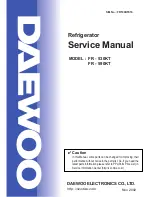
8
Freezer
The freezer compartment will become progressively
covered with frost. This should be removed with the
special plastic scraper provided, whenever the
thickness of the frost exceeds 4 mm.
During this operation it is not necessary to switch off
the power supply or to remove the foodstuffs.
However, when the ice becomes very thick on the
inner liner, complete defrosting should be carried out
and it is advisable to carry out this operation when
the appliance is empty.
To carry out complete defrosting proceed as follows:
1. pull out the plug from the wall socket or turn the
thermostat knob to the ÇOÈ setting;
2. remove any stored food, wrap it in several layers
of newspaper and put it in a cool place;
3. Leave the door open and insert the plastic scraper
under the channel in the centre of the lower part of
the appliance, place a low-sided container
beneath the scraper to collect the defrost water
(see Fig.).
4. When defrosting is completed, dry the interior
thoroughly.
Keep the scraper for future use.
Turn the thermostat knob back to the required setting
or replace the plug in the power socket. After two or
three hours, reload the previously removed food into
the compartment.
Important
A temperature rise of the frozen food packs,
during defrosting, may shorten their safe
storage life.
When defrosting the freezer, the fridge is also
controlled by the thermostat and will not be
operational during this period.
Defrosting
Refrigerator
The refrigerator automatically defrosts every time the
compressor stops. The water is discharged, via the
pipe, into a tray located below the appliance, where it
evaporates.
Important
To avoid defrost water overflowing into the
fridge, periodically clean the water discharge
hole in the centre of the V shaped drip
collector at the back of the refrigerator
compartment behind the fruit and vegetable
drawers. Use the special cleaner provided
which you will find already inserted into the
discharge hole.


































